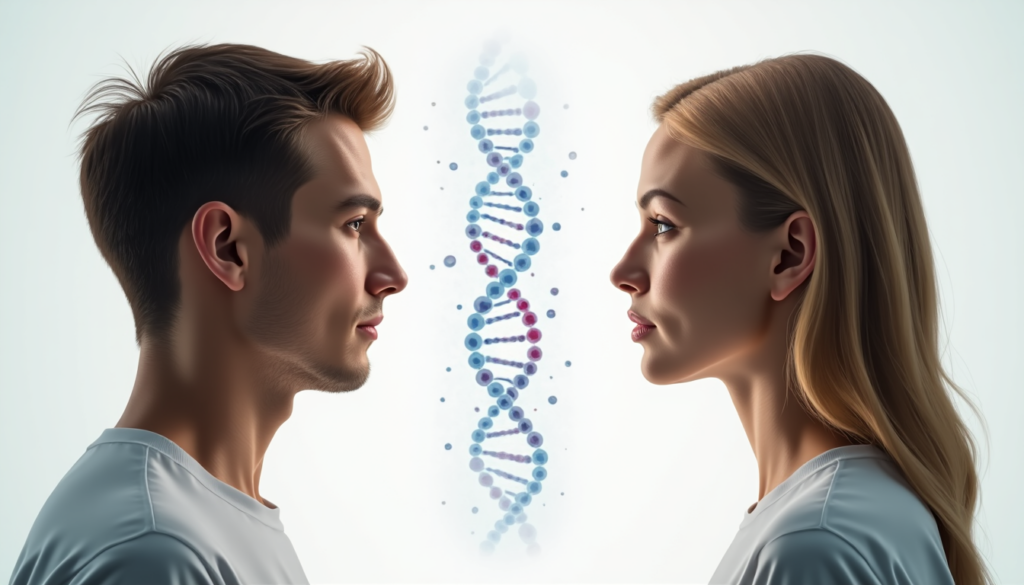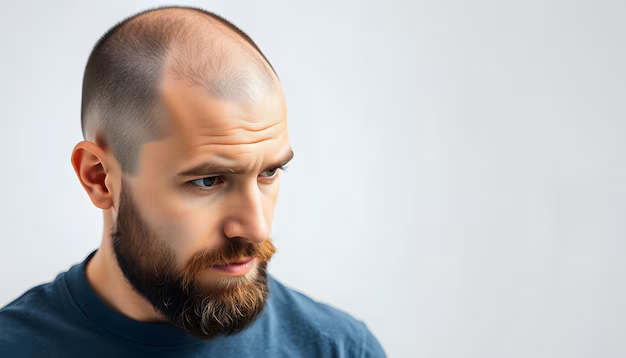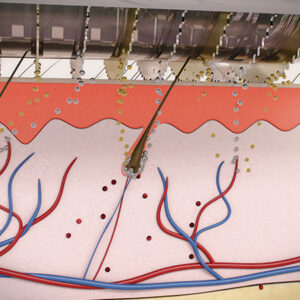Dealing with hair loss can be a distressing experience for many individuals. As medical science advances, various treatment options have emerged to combat this common issue. Among these, finasteride has gained significant attention as an effective prescription hair growth pill for those struggling with thinning hair or baldness. This comprehensive guide delves into the intricacies of finasteride, exploring its uses, effectiveness, and potential considerations for those contemplating this treatment option.
Hair loss affects millions of people worldwide, impacting not just physical appearance but also self-esteem and confidence. While there are numerous causes of hair loss, androgenetic alopecia – commonly known as male pattern baldness – is one of the most prevalent forms. This condition, which can affect both men and women, is characterized by a gradual thinning of hair on the scalp, often resulting in a receding hairline or bald spots.
Finasteride, initially developed to treat enlarged prostates, has shown remarkable efficacy in addressing hair loss. This FDA-approved medication works by targeting the hormonal factors that contribute to hair thinning, offering hope to those seeking to maintain or regrow their hair. Finasteride is primarily used for treating male pattern baldness, but it’s also being studied for finasteride for alopecia in other forms. As we explore the various aspects of finasteride, from its mechanism of action to potential side effects, we aim to provide a comprehensive understanding of this treatment option.
Whether you’re considering finasteride for the first time or looking to deepen your knowledge about this medication, this guide offers valuable insights to help you make informed decisions about your hair health. Let’s embark on this journey to uncover the potential of finasteride in combating hair loss and restoring confidence.

Understanding Finasteride
Finasteride is a medication that has revolutionized the treatment of hair loss, particularly male pattern baldness. Originally developed to address prostate issues, researchers discovered its remarkable ability to promote hair growth and slow down hair loss. This serendipitous finding has since transformed the lives of many individuals struggling with thinning hair.
At its core, finasteride belongs to a class of drugs known as 5-alpha-reductase inhibitors. These medications work by interfering with the conversion of testosterone to dihydrotestosterone (DHT), a hormone that plays a significant role in hair loss. By reducing DHT levels in the scalp, finasteride helps to create an environment more conducive to hair growth and retention.
The journey of finasteride from a prostate medication to a hair loss treatment is a testament to the often unexpected paths of medical discoveries. Its effectiveness in treating androgenetic alopecia has made it a go-to option for many individuals seeking to address their finasteride balding concerns. The medication is available in tablet form and is typically prescribed for daily use.
One of the key advantages of finasteride is its targeted action. Unlike some other hair loss treatments that may affect the entire body, finasteride primarily focuses on the scalp area. This targeted approach not only enhances its effectiveness but also helps to minimize potential side effects in other parts of the body.
It’s important to note that while finasteride is highly effective for many individuals, it’s not a one-size-fits-all solution. The medication’s efficacy can vary from person to person, and it may take several months of consistent use before noticeable results are observed. Additionally, the effects of finasteride are generally maintained only as long as the medication is continued, highlighting the importance of ongoing treatment for sustained results.
Understanding the basics of finasteride sets the foundation for exploring its benefits, potential side effects, and proper usage. As we delve deeper into these aspects, it becomes clear why finasteride has become a cornerstone in the treatment of hair loss, offering hope and tangible results to those seeking to restore their hair and confidence.
How Finasteride Works
The mechanism of action behind finasteride’s effectiveness in treating hair loss is both fascinating and complex. At its core, finasteride targets a key enzyme in the body that plays a crucial role in hair loss: Type II 5-alpha-reductase. This enzyme is responsible for converting testosterone into dihydrotestosterone (DHT), a hormone that is known to contribute significantly to male pattern baldness.
When finasteride is introduced into the body, it acts as an inhibitor of Type II 5-alpha-reductase. By doing so, it effectively reduces the conversion of testosterone to DHT. This reduction in DHT levels is particularly important in the context of hair loss because DHT is known to shrink hair follicles, leading to thinner, weaker hair and eventually hair loss.
The impact of finasteride on DHT levels is substantial. Studies have shown that the medication can lower DHT levels in the scalp by as much as 60-70%. This significant reduction creates a more favorable environment for hair growth and helps to slow down or even halt the progression of hair loss.
It’s important to understand that finasteride doesn’t directly stimulate hair growth. Instead, it works by removing one of the key factors that contribute to hair loss. By reducing DHT levels, finasteride allows existing hair follicles to thrive and potentially reverses the miniaturization of hair follicles that occurs in male pattern baldness.
The effects of finasteride are not immediate, and it typically takes several months of consistent use before noticeable results are observed. This is because the hair growth cycle is a slow process, and it takes time for the reduced DHT levels to impact the hair follicles positively.
One of the unique aspects of finasteride’s mechanism of action is its specificity. The medication primarily affects the Type II 5-alpha-reductase enzyme, which is predominantly found in hair follicles and the prostate gland. This targeted action helps to minimize potential systemic effects in other parts of the body.
It’s worth noting that while finasteride is highly effective in many cases, its efficacy can vary from person to person. Factors such as the extent of hair loss, the individual’s response to the medication, and the duration of treatment can all influence the overall results.
Understanding how finasteride works provides valuable insight into its potential benefits and limitations. This knowledge can help individuals make informed decisions about whether finasteride is the right choice for their hair loss concerns and what to expect from the treatment.
Dosage and Administration
When it comes to using finasteride for hair loss, proper dosage and administration are crucial for achieving optimal results while minimizing potential side effects. The recommended dosage of finasteride for treating male pattern baldness is typically finasteride 1mg per day. This dosage has been extensively studied and found to be effective in promoting hair growth and preventing further hair loss in many individuals.
Finasteride is available as a prescription drug in tablet form and is designed to be taken orally. It’s generally recommended to take the medication at the same time each day to maintain consistent levels in the body. The tablet can be taken with or without food, making it convenient for most people to incorporate into their daily routine.
One of the key aspects of finasteride treatment is consistency. For the medication to be effective, it needs to be taken regularly. Missing doses or taking the medication sporadically can reduce its effectiveness. It’s important for individuals to understand that finasteride is not a cure for hair loss but rather a treatment that needs to be continued to maintain its benefits.
The duration of treatment with finasteride can vary depending on individual needs and responses. In many cases, individuals may need to continue taking the medication indefinitely to maintain the benefits. If treatment is discontinued, any gains in hair growth are typically lost within 12 months, and hair loss may resume.
It’s worth noting that while the standard dosage for hair loss treatment is finasteride 1mg per day, finasteride 5mg is also available for treating benign prostatic hyperplasia (BPH). These higher doses are not recommended for hair loss treatment and should only be used under the guidance of a healthcare professional for their intended purpose.
For individuals considering finasteride, it’s crucial to consult with a healthcare provider before starting treatment. A medical professional can assess the individual’s specific situation, discuss potential benefits and risks, and determine if finasteride is an appropriate treatment option. It’s important to note that finasteride is not available over the counter and requires a prescription.
In some cases, healthcare providers may recommend combining oral finasteride for hair loss with other treatments, such as minoxidil, for enhanced results. This combination approach can be particularly effective for some individuals, but it should always be done under medical supervision.
It’s important to note that finasteride is not approved for use in women, particularly those who are or may become pregnant. The medication can cause birth defects in male fetuses, and pregnant women should not even handle crushed or broken finasteride tablets.
Proper storage of finasteride is also important. The medication should be kept at room temperature, away from moisture and direct light. It’s crucial to keep finasteride out of reach of children and to dispose of any unused medication properly.
Understanding the correct dosage and administration of finasteride is essential for anyone considering this treatment for hair loss. By following the recommended guidelines and maintaining open communication with a healthcare provider, individuals can maximize the potential benefits of finasteride while minimizing risks.
Effectiveness and Results
The effectiveness of finasteride in treating hair loss has been the subject of numerous studies and clinical trials. Overall, the results have been largely positive, with many individuals experiencing significant improvements in hair growth and a reduction in hair loss progression. However, it’s important to understand that the effectiveness can vary from person to person, and results may take time to become noticeable.
Clinical studies have shown that finasteride can be highly effective in treating male pattern baldness. In one long-term study, approximately two-thirds of men who took finasteride for five years experienced improved hair growth. The remaining third maintained their hair count, effectively halting further hair loss. These results are particularly impressive when compared to the natural progression of male pattern baldness, where continued hair loss is typically expected.
The effectiveness of finasteride is often most noticeable in the crown area and the middle of the scalp. Many users report increased hair thickness and density in these areas. The medication can also help to slow or stop hair loss at the hairline, although regrowth in this area may be less pronounced. Finasteride hair regrowth is a significant benefit for many users, with improvements in both hair quantity and quality often reported.
It’s important to note that the full effects of finasteride may not be immediately apparent. Most individuals start to see noticeable improvements after about three to six months of consistent use. However, it can take up to a year or more to see the maximum benefit. This gradual improvement aligns with the natural hair growth cycle, which typically spans several months.
Photographic evidence and hair count measurements are often used to assess the effectiveness of finasteride. Many users report not only an increase in hair count but also improvements in hair quality, with existing hair becoming thicker and more robust.
While finasteride has shown impressive results for many users, it’s not effective for everyone. Some individuals may not respond to the treatment or may experience only minimal improvements. Factors such as the extent of hair loss before starting treatment, age, and individual physiology can all influence the medication’s effectiveness.
It’s also crucial to understand that the benefits of finasteride are typically maintained only as long as the medication is continued. If treatment is stopped, any gained hair is likely to be lost within 6 to 12 months, and the natural progression of hair loss will resume.
For some individuals, combining finasteride with other hair loss treatments, such as minoxidil, can lead to enhanced results. This combination approach can be particularly effective for addressing different aspects of hair loss and promoting overall scalp hair growth.
While the focus is often on hair regrowth, one of the significant benefits of finasteride is its ability to prevent further hair loss. Even in cases where significant regrowth isn’t achieved, many users find value in maintaining their current hair and preventing further thinning.
It’s important for individuals considering finasteride to have realistic expectations. While the medication can be highly effective, it’s not a miracle cure for baldness. Results can vary, and ongoing use is necessary to maintain any improvements.
Regular follow-ups with a healthcare provider are recommended to monitor progress and assess the ongoing effectiveness of the treatment. These check-ins can also provide an opportunity to address any concerns or side effects that may arise during the course of treatment.
Understanding the potential effectiveness and expected results of finasteride can help individuals make informed decisions about their hair loss treatment. While the medication has shown promising results for many, it’s essential to approach treatment with realistic expectations and a commitment to long-term use for optimal results.

Side Effects and Risks
While finasteride has proven to be an effective treatment for hair loss, it’s important to be aware of potential side effects and risks associated with its use. Like all medications, finasteride can cause adverse reactions in some individuals. Understanding these potential side effects can help users make informed decisions and know what to watch for during treatment.
One of the most commonly reported finasteride side effects is related to sexual function. A small percentage of men may experience decreased libido, erectile dysfunction, or ejaculation disorders. These sexual side effects are typically mild and occur in less than 2% of men taking the medication. In most cases, these effects resolve on their own over time or after discontinuing the medication. It’s worth noting that these side effects are similar to those associated with Propecia, as Propecia is simply the brand name for finasteride.
Some men may also experience testicular pain or discomfort. This side effect is generally rare and often resolves without intervention. However, if persistent or severe, it should be reported to a healthcare provider.
Another potential side effect is breast changes, including breast tenderness or enlargement (gynecomastia). This occurs in a very small percentage of men and is thought to be related to the medication’s effects on hormone levels. If this side effect occurs, it’s important to consult with a healthcare provider for evaluation.
There have been reports of mood changes, including depression and anxiety, in some individuals taking finasteride. While these occurrences are rare, they should be taken seriously. Any significant changes in mood or mental health should be promptly reported to a healthcare provider.
It’s important to note that the risk of serious side effects from finasteride is generally low. However, there have been concerns raised about the potential for long-term side effects, particularly related to sexual function. Some individuals have reported persistent sexual side effects even after discontinuing the medication, a phenomenon sometimes referred to as Post-Finasteride Syndrome (PFS). While this is a topic of ongoing research and debate, it’s an important consideration for those contemplating finasteride use.
Finasteride can affect prostate specific antigen (PSA) levels, which are used in screening for prostate cancer. Men taking finasteride should inform their healthcare providers, as PSA test results may need to be interpreted differently.
There have been concerns about a potential link between finasteride use and an increased risk of high-grade prostate cancer. While studies have shown a reduced overall risk of prostate cancer in men taking finasteride, there was a slight increase in the detection of high-grade tumors. This finding is still being studied and debated in the medical community.
Finasteride is not approved for use in women, particularly those who are or may become pregnant. The medication can cause birth defects in male fetuses, and pregnant women should not even handle crushed or broken finasteride tablets.
It’s crucial for individuals taking finasteride to be aware of these potential side effects and to report any unusual symptoms to their healthcare provider promptly. Regular check-ups and open communication with a healthcare professional can help monitor for any adverse effects and ensure the safe and effective use of the medication.
While the list of potential side effects may seem daunting, it’s important to remember that many people take finasteride without experiencing significant adverse effects. The benefits of the medication in treating hair loss often outweigh the risks for many individuals. However, the decision to use finasteride should be made in consultation with a healthcare provider, taking into account individual health factors and personal preferences.
Understanding the potential risks and side effects of finasteride is an essential part of making an informed decision about hair loss treatment. By being aware of these possibilities, users can better monitor their health and work closely with their healthcare providers to ensure the safest and most effective use of the medication. The question “Is finasteride safe?” is complex and depends on individual factors, but for many, the benefits outweigh the potential risks when used under proper medical supervision.
Comparing Finasteride to Other Hair Loss Treatments
When it comes to addressing hair loss, finasteride is just one of several treatment options available. Understanding how finasteride compares to other hair loss treatments can help individuals make informed decisions about the best approach for their specific situation. Let’s explore some of the most common alternatives and how they stack up against finasteride.
Minoxidil is perhaps the most well-known alternative to finasteride. Available over-the-counter, minoxidil is a topical solution or foam that is applied directly to the scalp. Unlike finasteride, which works by reducing DHT levels, minoxidil is thought to work by improving blood flow to hair follicles and prolonging the growth phase of the hair cycle.
One advantage of minoxidil is its availability without a prescription and its suitability for both men and women. However, it requires twice-daily application, which some may find inconvenient. In terms of effectiveness, studies have shown that oral finasteride for hair loss is generally more effective than minoxidil, particularly for treating male pattern baldness.
Hair transplantation is another option for those seeking to address hair loss. This surgical procedure involves moving hair follicles from areas of the scalp with thicker growth to areas experiencing thinning or baldness. While hair transplantation can provide dramatic results, it is more invasive and expensive than medication-based treatments like finasteride.
Many individuals choose to combine finasteride with other treatments, particularly minoxidil, for enhanced results. This combination approach can be particularly effective, addressing hair loss through multiple mechanisms.
Platelet-rich plasma (PRP) therapy is a newer treatment option that involves injecting a concentration of a patient’s own platelets into the scalp to stimulate hair growth. While promising, PRP is still considered an experimental treatment, and its long-term effectiveness compared to finasteride is not yet fully established.
Low-level laser therapy (LLLT) devices are another alternative, using light energy to stimulate hair follicles. These devices can be used at home and are generally considered safe, but their effectiveness compared to finasteride varies, and more research is needed to fully understand their long-term benefits.
Natural remedies and supplements, such as saw palmetto or biotin, are often marketed for hair loss. While some individuals report benefits from these treatments, their effectiveness is generally not as well-established or consistent as finasteride.
One key advantage of finasteride over many other treatments is its convenience. As an oral medication taken once daily, it requires less day-to-day effort than topical treatments or more involved procedures. Additionally, its effects are more systemic, potentially benefiting the entire scalp rather than just the areas of application.
However, finasteride’s potential side effects, particularly those related to sexual function, are a consideration that sets it apart from some other treatments. While these side effects are relatively rare, they are not typically associated with topical treatments like minoxidil.
Cost is another factor to consider when comparing treatments. While finasteride requires a prescription and ongoing use, its long-term costs may be lower than some surgical options or high-end topical treatments. The availability of finasteride in Canada and other countries may vary, so it’s important to check local regulations and pricing.
It’s also worth noting that finasteride’s effectiveness is generally more consistent and well-documented compared to many alternative treatments. Its mechanism of action is well understood, and its results have been demonstrated in numerous clinical studies.
Ultimately, the choice between finasteride and other hair loss treatments depends on various factors, including the extent and pattern of hair loss, individual health considerations, personal preferences, and lifestyle factors. Many individuals find that a combination of treatments, often including finasteride, provides the best results.
When considering hair loss treatments, it’s crucial to consult with a healthcare provider or a specialist in hair restoration. They can provide personalized advice based on individual circumstances and help develop a comprehensive treatment plan that may include finasteride along with other complementary approaches.
Finasteride for Women
While finasteride is primarily known and approved for treating male pattern baldness, there has been growing interest in its potential use for women experiencing hair loss. However, the use of finasteride in women is a complex and somewhat controversial topic that requires careful consideration.
First and foremost, it’s crucial to understand that finasteride is not FDA-approved for use in women, particularly those who are or may become pregnant. The medication can cause birth defects in male fetuses, making it contraindicated for women of childbearing age.
Despite these restrictions, some healthcare providers may prescribe finasteride off-label to postmenopausal women experiencing hair loss. The dosage used in these cases is typically lower than that prescribed for men, often around 2.5 to 5 mg daily.
The effectiveness of finasteride in treating female pattern hair loss is less well-established than its use in men. While some studies have shown promising results, the overall body of research is limited compared to studies on male subjects.
One of the challenges in using finasteride for women is that female pattern hair loss often has different underlying causes compared to male pattern baldness. While DHT plays a role in both, hormonal imbalances, nutritional deficiencies, and other factors may contribute more significantly to hair loss in women.
For women considering finasteride, it’s essential to have a thorough evaluation by a healthcare provider specializing in hair loss. This evaluation should include a comprehensive medical history, blood tests to check hormone levels, and possibly a scalp biopsy to rule out other causes of hair loss.
Alternative treatments that may be more suitable for women experiencing hair loss include topical minoxidil, which is FDA-approved for use in women, and other therapies like low-level laser therapy or platelet-rich plasma injections.
It’s worth noting that some women may experience side effects from finasteride, including changes in libido or mood. These side effects can be particularly concerning given the limited data on long-term use of finasteride in women.
For women who do use finasteride, close monitoring by a healthcare provider is essential. Regular check-ups and assessments can help track progress and monitor for any potential side effects or complications.
Given the complexities and potential risks associated with finasteride use in women, it’s crucial for any woman considering this treatment to have an in-depth discussion with a healthcare provider. They can provide personalized advice based on individual circumstances and help weigh the potential benefits against the risks.
In conclusion, while finasteride may offer potential benefits for some women experiencing hair loss, its use remains controversial and requires careful consideration. As research in this area continues to evolve, it’s possible that new insights and guidelines for the use of finasteride in women may emerge in the future.
Best selling hair growth products:
Long-Term Use and Maintenance
For individuals considering finasteride as a long-term solution for hair loss, understanding the implications of prolonged use is crucial. Finasteride is not a one-time treatment but rather an ongoing therapy that requires consistent use to maintain its benefits. This section explores what users can expect from long-term finasteride use and how to effectively maintain results over time.
One of the key aspects of long-term finasteride use is the need for continuous treatment. The effects of finasteride on hair growth are not permanent and typically last only as long as the medication is taken. Studies have shown that the majority of men who use finasteride experience continued benefits for as long as they take the medication, with many maintaining improved hair growth for five years or more.
However, it’s important to note that if finasteride treatment is discontinued, any gains in hair growth are likely to be lost within 6 to 12 months. The natural progression of hair loss typically resumes once the medication is stopped. This aspect of finasteride treatment underscores the importance of viewing it as a long-term commitment rather than a short-term solution.
For many users, the first year of treatment is crucial in determining the effectiveness of finasteride. Most individuals start to see noticeable improvements within 3 to 6 months, with maximum benefits often observed after about a year of consistent use. After this initial period, the focus shifts to maintaining these gains and preventing further hair loss.
Long-term users of finasteride often report a stabilization of their hair loss, with many experiencing continued improvements in hair thickness and density over time. However, it’s important to have realistic expectations. While finasteride can be highly effective in maintaining existing hair and promoting new growth, it may not completely reverse advanced hair loss.
Regular follow-ups with a healthcare provider are an essential part of long-term finasteride use. These check-ups allow for monitoring of the medication’s effectiveness, assessment of any side effects, and adjustments to the treatment plan if necessary. Many healthcare providers recommend annual visits to evaluate progress and discuss any concerns.
For some individuals, combining finasteride with other hair loss treatments can enhance long-term results. For example, using topical minoxidil in conjunction with finasteride can provide a multi-faceted approach to hair loss treatment, potentially leading to better overall outcomes.
It’s also important to consider the potential long-term side effects of finasteride use. While most side effects, if they occur, tend to be mild and often resolve over time, some individuals may experience persistent issues. Ongoing communication with a healthcare provider is crucial for addressing any side effects and making informed decisions about continuing treatment.
Maintaining overall scalp and hair health is another important aspect of long-term finasteride use. This includes proper hair care practices, a balanced diet rich in nutrients that support hair health, and managing stress levels, which can impact hair growth.
Some users may find that the effectiveness of finasteride diminishes somewhat over time. In such cases, healthcare providers may recommend adjusting the treatment plan, which could involve changing the dosage or incorporating additional therapies.
It’s worth noting that the long-term safety profile of finasteride is generally considered favorable, with many men using the medication for years without significant issues. However, ongoing research continues to evaluate the long-term effects of finasteride use, particularly concerning sexual function and prostate health.
For those considering finasteride as a long-term solution for hair loss, it’s essential to weigh the commitment required against the potential benefits. The decision to use finasteride long-term should be made in consultation with a healthcare provider, taking into account individual health factors, personal goals, and the understanding that it is an ongoing treatment rather than a cure.
In conclusion, long-term use of finasteride can be an effective strategy for managing hair loss, but it requires commitment, regular monitoring, and a comprehensive approach to hair and scalp health. By understanding what to expect from long-term use and how to maintain results effectively, individuals can make informed decisions about their hair loss treatment journey.
Finasteride and Prostate Health
While finasteride is widely known for its use in treating hair loss, it’s important to understand its original purpose and its significant impact on prostate health. Initially developed to treat benign prostatic hyperplasia (BPH), finasteride’s effects on the prostate gland are a crucial aspect of its overall profile.
Finasteride works by inhibiting the enzyme 5-alpha-reductase, which is responsible for converting testosterone to dihydrotestosterone (DHT). In the context of prostate health, this reduction in DHT levels can have several beneficial effects, particularly in men with BPH.
For men with BPH, finasteride can help reduce the size of the enlarged prostate gland. This reduction in size can lead to significant improvements in urinary symptoms associated with BPH, such as frequent urination, difficulty starting urination, and weak urine flow. The typical dose for treating BPH is finasteride 5mg daily, which is higher than the 1 mg dose used for hair loss treatment.
One of the most notable aspects of finasteride’s impact on prostate health is its potential role in prostate cancer prevention. Large-scale studies have shown that men taking finasteride have a reduced overall risk of developing prostate cancer. However, this finding comes with an important caveat.
While finasteride appears to reduce the overall incidence of prostate cancer, some studies have suggested a slight increase in the detection of high-grade prostate tumors among men taking the medication. This finding has been the subject of much debate and ongoing research in the medical community.
It’s important to note that finasteride can affect prostate specific antigen (PSA) levels, which are commonly used in screening for prostate cancer. Finasteride typically lowers PSA levels by about 50%. This reduction needs to be taken into account when interpreting PSA test results in men taking finasteride, as it could potentially mask elevated PSA levels that might indicate prostate cancer.
For men taking finasteride for hair loss, the lower dose (1 mg) may still have some effects on prostate health, although these effects are generally less pronounced than with the higher dose used for BPH treatment. However, the potential impact on PSA levels is still relevant and should be considered in prostate cancer screening.
The relationship between finasteride and prostate health underscores the importance of regular check-ups and open communication with healthcare providers. Men taking finasteride, whether for hair loss or BPH, should inform their doctors about their use of the medication, particularly when undergoing prostate cancer screening or experiencing any urinary symptoms.
It’s also worth noting that the effects of finasteride on the prostate are generally reversible. If the medication is discontinued, prostate size and PSA levels typically return to their baseline levels within several months.
For men considering finasteride for hair loss, understanding its potential impacts on prostate health can provide a more comprehensive view of the medication’s effects on the body. While the lower dose used for hair loss treatment may have less significant effects on the prostate compared to the higher dose used for BPH, it’s still an important consideration in overall health management.
In conclusion, finasteride’s impact on prostate health is a crucial aspect of its overall profile. Whether used for hair loss or BPH treatment, the medication’s effects on the prostate gland and PSA levels highlight the importance of comprehensive health monitoring and regular communication with healthcare providers. Understanding these aspects can help individuals make more informed decisions about using finasteride and ensure appropriate monitoring of prostate health.

Finasteride and Sexual Health
One of the most discussed aspects of finasteride use is its potential impact on sexual health. While the medication has proven highly effective in treating hair loss and benign prostatic hyperplasia, concerns about sexual side effects have been a significant topic of discussion among users and healthcare providers alike.
The most commonly reported sexual side effects associated with finasteride include decreased libido, erectile dysfunction, and ejaculation disorders. These effects are thought to be related to the medication’s impact on hormone levels, particularly its reduction of dihydrotestosterone (DHT).
It’s important to note that while these side effects have been reported, they are relatively rare. Clinical studies have shown that sexual side effects occur in a small percentage of men taking finasteride, typically less than 2% of users. However, the actual incidence in real-world use may vary.
For most men who experience sexual side effects, these issues are mild and often resolve on their own over time, even with continued use of the medication. In some cases, the side effects may subside as the body adjusts to the medication. For others, discontinuing the medication typically leads to a resolution of these side effects.
However, there have been reports of persistent sexual side effects in some men, even after stopping finasteride. This phenomenon, sometimes referred to as Post-Finasteride Syndrome (PFS), has been a subject of ongoing research and debate in the medical community. While rare, these reports have raised concerns about the potential long-term impacts of finasteride on sexual function.
It’s crucial for individuals considering finasteride to have an open and honest discussion with their healthcare provider about these potential side effects. This conversation should include a thorough review of the individual’s medical history, current health status, and any pre-existing sexual health concerns.
For men who do experience sexual side effects while taking finasteride, there are several potential management strategies. These may include adjusting the dosage, taking breaks from the medication, or exploring alternative treatments for hair loss. In some cases, healthcare providers may recommend additional therapies to address sexual side effects while continuing finasteride treatment.
It’s worth noting that the relationship between finasteride and sexual function is complex and may be influenced by various factors. Age, overall health, stress levels, and other medications can all play a role in sexual function, making it important to consider these factors when evaluating any changes in sexual health.
Some studies have suggested that the psychological impact of hair loss itself can affect sexual confidence and function. In this context, the positive effects of finasteride on hair growth may actually improve sexual well-being for some individuals by boosting self-esteem and confidence.
For individuals who are particularly concerned about the potential sexual side effects of finasteride, there are alternative hair loss treatments available. These include topical medications like minoxidil, which do not have systemic effects and are not associated with sexual side effects.
It’s also important to consider that the dose of finasteride used for hair loss treatment (1 mg daily) is lower than that used for treating benign prostatic hyperplasia (5 mg daily). This lower dose may be associated with a reduced risk of side effects, including those related to sexual function.





